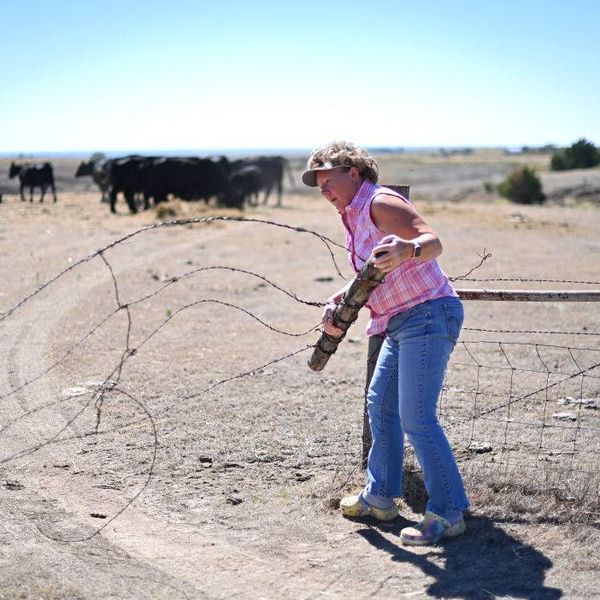Hundreds of First Nations People March to 'Ground Zero' of Tar Sands Destruction
Healing Walk organizers: 'We will smell the crude oil and toxic plumes. Some walkers will be forced to stop walking due to breathing difficulties or bloody noses.'
On Saturday, hundreds of First Nations people across Canada traveled to Alberta to look upon the savage destruction wrought by the extraction of tar sands oil from their Mother Earth.
The Healing Walk, which takes place June 27-29, marks the fifth and final such trip to the Athabasca tar sands. During the eight-hour tour, the group will take in some of the major "sites" of the Big Oil development projects, including a Syncrude upgrader, tailings ponds and heavy haul trucks.
"For the fifth year straight, we will smell the crude oil and toxic plumes, especially if the wind pushes back south," the march organizers write. "Some walkers, as in past years, will be forced to stop walking due to breathing difficulties or bloody noses. We will walk at ground zero of the oil sands, surrounded by vast oil sands mines."
In addition to the march, the hosts have organized several workshops, panels, stories and performances, which will culminate with a giant feast and prayer Saturday night. During the event, participants posted pictures on Twitter.
"We're not going out there for yet another protest, yet another rally," Chelsea Flook, a Healing Walk organizer since 2010, told DeSmog Blog Canada. "We're out there to be together, to heal, and those two things are very appealing in a context of seemingly endless struggle."
'The story of the Athabasca region is only one small piece of the immense scope of this issue, these practices, of the land that's being abused.'
The organizers are calling their decision to no longer hold the annual walks a "new beginning," rather than the end. "Our work will continue in the territory, with the people and communities, but, will look different," said Jesse Cardinal, a coordinator with the Keepers of the Athabasca, the main organizing group behind the Healing Walk.
"The story of the Athabasca region is only one small piece of the immense scope of this issue, these practices, of the land that's being abused, and of the people who are being so brutally mistreated," the walk organizers continue. "It's time for the Healing Walk to shed light on other communities, other extraction practices, other bodies of water, and other places that have been sacred since time immemorial."
An Urgent Message From Our Co-Founder
Dear Common Dreams reader, The U.S. is on a fast track to authoritarianism like nothing I've ever seen. Meanwhile, corporate news outlets are utterly capitulating to Trump, twisting their coverage to avoid drawing his ire while lining up to stuff cash in his pockets. That's why I believe that Common Dreams is doing the best and most consequential reporting that we've ever done. Our small but mighty team is a progressive reporting powerhouse, covering the news every day that the corporate media never will. Our mission has always been simple: To inform. To inspire. And to ignite change for the common good. Now here's the key piece that I want all our readers to understand: None of this would be possible without your financial support. That's not just some fundraising cliche. It's the absolute and literal truth. We don't accept corporate advertising and never will. We don't have a paywall because we don't think people should be blocked from critical news based on their ability to pay. Everything we do is funded by the donations of readers like you. Will you donate now to help power the nonprofit, independent reporting of Common Dreams? Thank you for being a vital member of our community. Together, we can keep independent journalism alive when it’s needed most. - Craig Brown, Co-founder |
On Saturday, hundreds of First Nations people across Canada traveled to Alberta to look upon the savage destruction wrought by the extraction of tar sands oil from their Mother Earth.
The Healing Walk, which takes place June 27-29, marks the fifth and final such trip to the Athabasca tar sands. During the eight-hour tour, the group will take in some of the major "sites" of the Big Oil development projects, including a Syncrude upgrader, tailings ponds and heavy haul trucks.
"For the fifth year straight, we will smell the crude oil and toxic plumes, especially if the wind pushes back south," the march organizers write. "Some walkers, as in past years, will be forced to stop walking due to breathing difficulties or bloody noses. We will walk at ground zero of the oil sands, surrounded by vast oil sands mines."
In addition to the march, the hosts have organized several workshops, panels, stories and performances, which will culminate with a giant feast and prayer Saturday night. During the event, participants posted pictures on Twitter.
"We're not going out there for yet another protest, yet another rally," Chelsea Flook, a Healing Walk organizer since 2010, told DeSmog Blog Canada. "We're out there to be together, to heal, and those two things are very appealing in a context of seemingly endless struggle."
'The story of the Athabasca region is only one small piece of the immense scope of this issue, these practices, of the land that's being abused.'
The organizers are calling their decision to no longer hold the annual walks a "new beginning," rather than the end. "Our work will continue in the territory, with the people and communities, but, will look different," said Jesse Cardinal, a coordinator with the Keepers of the Athabasca, the main organizing group behind the Healing Walk.
"The story of the Athabasca region is only one small piece of the immense scope of this issue, these practices, of the land that's being abused, and of the people who are being so brutally mistreated," the walk organizers continue. "It's time for the Healing Walk to shed light on other communities, other extraction practices, other bodies of water, and other places that have been sacred since time immemorial."
On Saturday, hundreds of First Nations people across Canada traveled to Alberta to look upon the savage destruction wrought by the extraction of tar sands oil from their Mother Earth.
The Healing Walk, which takes place June 27-29, marks the fifth and final such trip to the Athabasca tar sands. During the eight-hour tour, the group will take in some of the major "sites" of the Big Oil development projects, including a Syncrude upgrader, tailings ponds and heavy haul trucks.
"For the fifth year straight, we will smell the crude oil and toxic plumes, especially if the wind pushes back south," the march organizers write. "Some walkers, as in past years, will be forced to stop walking due to breathing difficulties or bloody noses. We will walk at ground zero of the oil sands, surrounded by vast oil sands mines."
In addition to the march, the hosts have organized several workshops, panels, stories and performances, which will culminate with a giant feast and prayer Saturday night. During the event, participants posted pictures on Twitter.
"We're not going out there for yet another protest, yet another rally," Chelsea Flook, a Healing Walk organizer since 2010, told DeSmog Blog Canada. "We're out there to be together, to heal, and those two things are very appealing in a context of seemingly endless struggle."
'The story of the Athabasca region is only one small piece of the immense scope of this issue, these practices, of the land that's being abused.'
The organizers are calling their decision to no longer hold the annual walks a "new beginning," rather than the end. "Our work will continue in the territory, with the people and communities, but, will look different," said Jesse Cardinal, a coordinator with the Keepers of the Athabasca, the main organizing group behind the Healing Walk.
"The story of the Athabasca region is only one small piece of the immense scope of this issue, these practices, of the land that's being abused, and of the people who are being so brutally mistreated," the walk organizers continue. "It's time for the Healing Walk to shed light on other communities, other extraction practices, other bodies of water, and other places that have been sacred since time immemorial."

